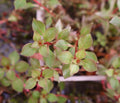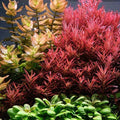Avoid These Common Mistakes to Ensure Your Shrimp Thrive in Your Aquarium
Shrimp keeping is a fascinating and rewarding hobby that has gained popularity among aquatic enthusiasts. In this article, we'll talk about the common mistakes beginning shrimp keepers often make and we will provide valuable tips on how to avoid them. Continue reading to ensure the health and longevity of your aquatic companions.
1. Buying From a Bad Source:
One common pitfall for new shrimp keepers is purchasing their shrimp from unreliable sources. Shrimp are known for their rapid reproduction, making it essential to start with healthy, disease-free specimens. A bad breeder, someone who neglects proper care and breeding practices, can lead to issues in your aquarium.
To avoid this mistake, choose a reputable source for your shrimp. Visit local fish stores and observe how quickly they turn over their stock. Online suppliers with positive reviews, like shrimpfarm.com, are excellent options. Ensuring the quality of your shrimp source is a critical step towards successful shrimp keeping.
2. Neglecting Research Before Purchase:
Not all shrimp species are the same, and their care requirements can vary significantly. It's essential to research the specific breed of shrimp you intend to keep, especially considering factors like water parameters, diet, and compatibility with your tank setup. Neglecting this research can lead to shrimp that struggle to thrive in your aquarium.
Start with hardy shrimp species like Red Cherry shrimp or Yellow shrimp if you're new to the hobby. As you gain experience, you can explore more exotic species that may be better suited to your water conditions. Always ensure you can meet the requirements of your chosen shrimp breed to set them up for success.
3. Starting with High-End Shrimp:
While high-end shrimp can be incredibly stunning and tempting, they come with a hefty price tag. For beginners, investing in these expensive shrimp may not be the wisest choice. High-end shrimp are often more delicate and less forgiving of mistakes common among newcomers.
Instead, consider starting with more forgiving and affordable options like Red Cherry shrimp or Blue Dream shrimp. These species are beautiful and can thrive with proper care, allowing you to gain experience before diving into high-end shrimp keeping.
4. Adding Shrimp to a Newly Set Up Aquarium Too Quickly:
Shrimp are meticulous grazers that rely on biofilm, a thin layer of bacteria, algae, and fungi, for a significant portion of their diet. In a new aquarium, biofilm takes time to develop naturally. Adding shrimp too soon to a freshly established tank with minimal biofilm can lead to starvation, even if you're providing additional food.
To ensure your shrimp have a healthy diet, allow your aquarium to mature for at least a couple of weeks, ideally with live aquarium plants. Once you notice natural algae growth, it's a good indicator that the tank is ready for shrimp. Patience in this step is crucial for the long-term success of your shrimp colony.
5. Not Feeding Shrimp Enough:
Many newcomers to shrimp keeping assume that these crustaceans will thrive by scavenging leftover fish food. While they will consume some remnants, it's essential to target feed your shrimp regularly. Neglecting their dietary needs can lead to malnutrition and a shorter lifespan for your shrimp.
To provide optimal care, feed your shrimp several times a week with high-quality shrimp-specific food. A feeding schedule of every other day or every third day, depending on the number of shrimp in your tank, can help ensure their health and well-being.
One Top Tip for Shrimp Keepers:
The top tip for all shrimp keepers, whether novice or experienced, is to provide ample hiding places in your aquarium. Contrary to what you might think, more hiding spots lead to more visible and active shrimp. When shrimp feel safe and secure with hiding places nearby, they are more likely to explore their environment.
Create a diverse and interesting landscape within your tank by incorporating caves, driftwood, and live plants. By avoiding these common mistakes and following our tips, you can ensure that your shrimp thrive in their aquatic home. Remember, patience and research are key to creating a thriving and beautiful shrimp aquarium. Happy shrimp keeping!
1. Buying From a Bad Source:
One common pitfall for new shrimp keepers is purchasing their shrimp from unreliable sources. Shrimp are known for their rapid reproduction, making it essential to start with healthy, disease-free specimens. A bad breeder, someone who neglects proper care and breeding practices, can lead to issues in your aquarium.
To avoid this mistake, choose a reputable source for your shrimp. Visit local fish stores and observe how quickly they turn over their stock. Online suppliers with positive reviews, like shrimpfarm.com, are excellent options. Ensuring the quality of your shrimp source is a critical step towards successful shrimp keeping.
2. Neglecting Research Before Purchase:
Not all shrimp species are the same, and their care requirements can vary significantly. It's essential to research the specific breed of shrimp you intend to keep, especially considering factors like water parameters, diet, and compatibility with your tank setup. Neglecting this research can lead to shrimp that struggle to thrive in your aquarium.
Start with hardy shrimp species like Red Cherry shrimp or Yellow shrimp if you're new to the hobby. As you gain experience, you can explore more exotic species that may be better suited to your water conditions. Always ensure you can meet the requirements of your chosen shrimp breed to set them up for success.
3. Starting with High-End Shrimp:
While high-end shrimp can be incredibly stunning and tempting, they come with a hefty price tag. For beginners, investing in these expensive shrimp may not be the wisest choice. High-end shrimp are often more delicate and less forgiving of mistakes common among newcomers.
Instead, consider starting with more forgiving and affordable options like Red Cherry shrimp or Blue Dream shrimp. These species are beautiful and can thrive with proper care, allowing you to gain experience before diving into high-end shrimp keeping.
4. Adding Shrimp to a Newly Set Up Aquarium Too Quickly:
Shrimp are meticulous grazers that rely on biofilm, a thin layer of bacteria, algae, and fungi, for a significant portion of their diet. In a new aquarium, biofilm takes time to develop naturally. Adding shrimp too soon to a freshly established tank with minimal biofilm can lead to starvation, even if you're providing additional food.
To ensure your shrimp have a healthy diet, allow your aquarium to mature for at least a couple of weeks, ideally with live aquarium plants. Once you notice natural algae growth, it's a good indicator that the tank is ready for shrimp. Patience in this step is crucial for the long-term success of your shrimp colony.
5. Not Feeding Shrimp Enough:
Many newcomers to shrimp keeping assume that these crustaceans will thrive by scavenging leftover fish food. While they will consume some remnants, it's essential to target feed your shrimp regularly. Neglecting their dietary needs can lead to malnutrition and a shorter lifespan for your shrimp.
To provide optimal care, feed your shrimp several times a week with high-quality shrimp-specific food. A feeding schedule of every other day or every third day, depending on the number of shrimp in your tank, can help ensure their health and well-being.
One Top Tip for Shrimp Keepers:
The top tip for all shrimp keepers, whether novice or experienced, is to provide ample hiding places in your aquarium. Contrary to what you might think, more hiding spots lead to more visible and active shrimp. When shrimp feel safe and secure with hiding places nearby, they are more likely to explore their environment.
Create a diverse and interesting landscape within your tank by incorporating caves, driftwood, and live plants. By avoiding these common mistakes and following our tips, you can ensure that your shrimp thrive in their aquatic home. Remember, patience and research are key to creating a thriving and beautiful shrimp aquarium. Happy shrimp keeping!
















